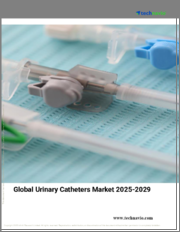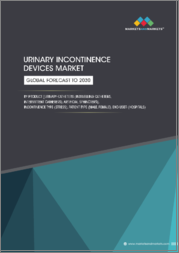
|
시장보고서
상품코드
1529060
세계의 요도 카테터 시장 : 제품 유형, 장치 유형, 재료, 환자, 용도, 최종 용도별 - 예측(2024-2032년)Urinary Catheters Market - By Product (Indwelling Catheters, Intermittent Catheters, External Catheters), Device Type (Coated, Uncoated), Material (Latex, PVC, Silicone), Patient (Adult, Pediatric), Application, End Use & Forecast, 2024 - 2032 |
||||||
요도 카테터 시장 규모는 세계 인구의 고령화, 요실금 유병률 증가, 방광 관련 질환 증가로 인해 2024년부터 2032년까지 연평균 4.4%의 성장률을 보일 것으로 예상됩니다.
세계암연구기금(World Cancer Research Fund International)의 데이터에 따르면, 2022년 전 세계적으로 1,467,854건의 전립선암이 새로 발생했다고 합니다. 전립선 관련 질환 증가율은 더 나은 질병 관리를 위한 요도 카테터에 대한 수요를 가속화하고 있습니다.
항균 코팅과 소재의 개선 등 카테터 기술의 눈부신 발전으로 환자의 편안함을 높이고 감염 위험을 감소시키고 있습니다. 비뇨기 건강에 대한 인식 증가, 의료비 지출 증가, 개발도상국의 의료 접근성 확대 등이 카테터에 대한 수요를 촉진하고 있습니다. 또한 저침습적 시술과 재택치료 솔루션에 대한 수요가 급증하면서 제품 채택을 촉진하고 있습니다.
제품별로는 요실금과 방광 질환의 유병률 증가로 인해 간헐적 카테터 부문의 요도 카테터 산업은 2024년부터 2032년까지 큰 성장률을 보일 것으로 추정됩니다. 카테터 기술의 발전으로 안전성과 사용 편의성이 향상되고 있습니다. 저침습적 솔루션에 대한 선호도가 높아지면서 카테터 수요를 촉진하고 있습니다. 자가 카테터 삽입에 대한 인식 증가, 재택치료 서비스 확대, 비뇨기 건강 관리에 대한 정부 지원은 이 분야의 성장을 가속할 것으로 보입니다.
용도별로는 수술 후 요도 카테터 산업은 수술 건수 증가에 힘입어 2024년에서 2032년 사이에 두드러진 성장률을 보일 것으로 추정됩니다. 수술 후 요폐 발생 건수 증가와 효과적인 수술 후 관리에 대한 인식이 높아지면서 제품 출시가 확대되고 있습니다. 수술적 개입이 필요한 노인 인구 증가도 수술 후 요도 카테터의 채택을 촉진하고 있습니다.
지역별로 보면 유럽의 요도 카테터 산업은 2024년부터 2032년까지 큰 폭의 성장을 보일 것으로 예상되며, 그 배경에는 고령화, 요실금 및 방광 질환의 유병률 증가, 카테터 기술의 발전이 있습니다. 의료비 지출 증가와 의료 인프라의 개선으로 요도 카테터 사용이 급증하고 있습니다. 비뇨기 건강에 대한 인식이 높아지고 최소침습적 치료에 대한 수요가 증가하면서 이 지역 시장 확대를 주도하고 있습니다.
목차
제1장 조사 방법과 조사 범위
제2장 주요 요약
제3장 업계 인사이트
- 생태계 분석
- 업계에 대한 영향요인
- 성장 촉진요인
- 업계의 잠재적 리스크&과제
- 성장 가능성 분석
- 규제 상황
- 상환 시나리오
- 카테터 관련 요로 감염(CAUTI) 시나리오
- Porter's Five Forces 분석
- PESTEL 분석
제4장 경쟁 구도
- 서론
- 기업 매트릭스 분석
- 기업 점유율 분석
- 경쟁 포지셔닝 매트릭스
- 전략 대시보드
제5장 시장 추산·예측 : 제품별, 2021-2032년
- 주요 동향
- 유치 카테터
- 경요도 카테터
- 치골상 카테터
- 간헐식 카테터
- 체외 카테터
- 남성용 체외 카테터
- 진공 보조 카테터
- 비진공 보조 카테터
- 여성용 체외 카테터
- 진공 보조 카테터
- 비진공 보조 카테터
- 남성용 체외 카테터
제6장 시장 추산·예측 : 디바이스 유형별, 2021-2032년
- 주요 동향
- 코팅
- 겔 윤활 카테터
- 친수성 코팅 카테터
- 은코팅 카테터
- 기타 코팅 디바이스
- 비코트
제7장 시장 추산·예측 : 재료별, 2021-2032년
- 주요 동향
- 라텍스
- PVC
- 실리콘
- 기타 재료
제8장 시장 추산·예측 : 환자별, 2021-2032년
- 주요 동향
- 성인
- 소아
제9장 시장 추산·예측 : 용도별, 2021-2032년
- 주요 동향
- 전립선 비대
- 요폐
- 요실금
- 수술 후
- 기타 용도
제10장 시장 추산·예측 : 용도별, 2021-2032년
- 주요 동향
- 병원
- 진료소
- 외래수술센터(ASC)
- 탁아소
- 장기 케어 시설
- 홈케어 시설
제11장 시장 추산·예측 : 지역별, 2021-2032년
- 주요 동향
- 북미
- 미국
- 캐나다
- 유럽
- 독일
- 영국
- 프랑스
- 이탈리아
- 스페인
- 네덜란드
- 기타 유럽
- 아시아태평양
- 중국
- 일본
- 인도
- 호주
- 한국
- 기타 아시아태평양
- 라틴아메리카
- 브라질
- 멕시코
- 아르헨티나
- 기타 라틴아메리카
- 중동 및 아프리카
- 사우디아라비아
- 남아프리카공화국
- 아랍에미리트(UAE)
- 기타 중동 및 아프리카
제12장 기업 개요
- Amsino International Inc.
- B Braun Melsungen AG
- Becton, Dickinson and Company
- Cardinal Health, Inc.
- Coloplast Ltd.
- ConvaTec
- Cook Medical
- Hollister Incorporated
- Medline Industries Inc.
- Medtronic PLC
- Teleflex
Urinary Catheters Market size is projected to grow at 4.4% CAGR from 2024 to 2032, led by the aging global population, increasing prevalence of urinary incontinence, and the rising incidences of bladder-related disorders. As per data from the World Cancer Research Fund International, in 2022, there were 1,467,854 new cases of prostate cancer across the globe. The increasing rate of prostate-related disorders is accelerating the demand for urinary catheters for better disease management.
Significant advancements in catheter technology, such as antimicrobial coatings and improved materials, are enhancing patient comfort and reducing infection risks. The growing awareness about urinary health, increasing healthcare spending, and expanding access to medical care in developing regions are spurring the demand for these catheters. The surging demand for minimally invasive procedures and home healthcare solutions is also boosting product adoption.
The overall market is segregated into product, device type, material, patient, application, end-use, and region.
Based on product, the urinary catheters industry from the intermittent catheters segment is estimated to grow at a significant rate between 2024 and 2032, owing to the increasing prevalence of urinary incontinence and bladder disorders. Rising advancements in catheter technology are enhancing safety and ease of use. The growing preference for minimally invasive solutions is also spurring the demand for these catheters. The rising awareness about self-catheterization, expanding home healthcare services, and government support for urinary health management will drive the segment growth.
With respect to application, the urinary catheters industry from the post-surgery segment is estimated to grow at a notable rate from 2024 to 2032, led by the increasing number of surgeries. The rising incidences of postoperative urinary retention and the growing awareness of effective post-operative care are increasing product deployment. The expanding geriatric population requiring surgical interventions is also spurring the adoption of urinary catheters in post-surgery applications.
Regionally, the Europe urinary catheters industry is estimated to witness substantial gains between 2024 and 2032, attributed to the aging population, increasing prevalence of urinary incontinence and bladder disorders as well as advancements in catheter technology. The rising healthcare spending and improving medical infrastructure are escalating the utilization of urinary catheters. The growing awareness of urinary health and the strong demand for minimally invasive treatments are driving the regional market progression.
Table of Contents
Chapter 1 Methodology & Scope
- 1.1 Market scope & definitions
- 1.2 Research design
- 1.2.1 Research approach
- 1.2.2 Data collection methods
- 1.3 Base estimates & calculations
- 1.3.1 Base year calculation
- 1.3.2 Key trends for market estimation
- 1.4 Forecast model
- 1.5 Primary research and validation
- 1.5.1 Primary sources
- 1.5.2 Data mining sources
Chapter 2 Executive Summary
- 2.1 Industry 360° synopsis
Chapter 3 Industry Insights
- 3.1 Industry ecosystem analysis
- 3.2 Industry impact forces
- 3.2.1 Growth drivers
- 3.2.1.1 Increasing prevalence of infectious diseases
- 3.2.1.2 Growing prevalence of urinary incontinence
- 3.2.1.3 Increasing incidence of prostate cancer
- 3.2.1.4 Favorable reimbursement scenario
- 3.2.1.5 Growing demand for self-catheterization coupled with expansion of ambulatory surgical centers
- 3.2.2 Industry pitfalls & challenges
- 3.2.2.1 Complications associated with catheterization and the availability of alternative treatment options
- 3.2.1 Growth drivers
- 3.3 Growth potential analysis
- 3.4 Regulatory landscape
- 3.5 Reimbursement scenario
- 3.6 Catheter associated urinary tract infection (CAUTI) scenario
- 3.7 Porter's analysis
- 3.8 PESTEL analysis
Chapter 4 Competitive Landscape, 2023
- 4.1 Introduction
- 4.2 Company matrix analysis
- 4.3 Company market share analysis
- 4.4 Competitive positioning matrix
- 4.5 Strategy dashboard
Chapter 5 Market Estimates and Forecast, By Product, 2021 - 2032 ($ Mn)
- 5.1 Key trends
- 5.2 Indwelling catheters
- 5.2.1 Transurethral catheters
- 5.2.2 Suprapubic catheters
- 5.3 Intermittent catheters
- 5.4 External catheters
- 5.4.1 Male external catheters
- 5.4.1.1 Vacuum-assisted catheters
- 5.4.1.2 Non-vacuum assisted catheters
- 5.4.2 Female external catheters
- 5.4.2.1 Vacuum-assisted catheters
- 5.4.2.2 Non-vacuum assisted catheters
- 5.4.1 Male external catheters
Chapter 6 Market Estimates and Forecast, By Device Type, 2021 - 2032 ($ Mn)
- 6.1 Key trends
- 6.2 Coated
- 6.2.1 Gel prelubricated catheters
- 6.2.2 Hydrophilic coated catheters
- 6.2.3 Silver coated catheters
- 6.2.4 Other coated devices
- 6.3 Uncoated
Chapter 7 Market Estimates and Forecast, By Material, 2021 - 2032 ($ Mn)
- 7.1 Key trends
- 7.2 Latex
- 7.3 PVC
- 7.4 Silicone
- 7.5 Other materials
Chapter 8 Market Estimates and Forecast, By Patient, 2021 - 2032 ($ Mn)
- 8.1 Key trends
- 8.2 Adult
- 8.3 Pediatric
Chapter 9 Market Estimates and Forecast, By Application, 2021 - 2032 ($ Mn)
- 9.1 Key trends
- 9.2 Prostate enlargement
- 9.3 Urinary retention
- 9.4 Urinary incontinence
- 9.5 Post surgery
- 9.6 Other applications
Chapter 10 Market Estimates and Forecast, By End-Use, 2021 - 2032 ($ Mn)
- 10.1 Key trends
- 10.2 Hospitals
- 10.3 Clinics
- 10.4 Ambulatory surgical centers
- 10.5 Day care centers
- 10.6 Long term care facilities
- 10.7 Home care facilities
Chapter 11 Market Estimates and Forecast, By Region, 2021 - 2032 ($ Mn)
- 11.1 Key trends
- 11.2 North America
- 11.2.1 U.S.
- 11.2.2 Canada
- 11.3 Europe
- 11.3.1 Germany
- 11.3.2 UK
- 11.3.3 France
- 11.3.4 Italy
- 11.3.5 Spain
- 11.3.6 Netherlands
- 11.3.7 Rest of Europe
- 11.4 Asia Pacific
- 11.4.1 China
- 11.4.2 Japan
- 11.4.3 India
- 11.4.4 Australia
- 11.4.5 South Korea
- 11.4.6 Rest of Asia Pacific
- 11.5 Latin America
- 11.5.1 Brazil
- 11.5.2 Mexico
- 11.5.3 Argentina
- 11.5.4 Rest of Latin America
- 11.6 Middle East and Africa
- 11.6.1 Saudi Arabia
- 11.6.2 South Africa
- 11.6.3 UAE
- 11.6.4 Rest of Middle East and Africa
Chapter 12 Company Profiles
- 12.1 Amsino International Inc.
- 12.2 B Braun Melsungen AG
- 12.3 Becton, Dickinson and Company
- 12.4 Cardinal Health, Inc.
- 12.5 Coloplast Ltd.
- 12.6 ConvaTec
- 12.7 Cook Medical
- 12.8 Hollister Incorporated
- 12.9 Medline Industries Inc.
- 12.10 Medtronic PLC
- 12.11 Teleflex



















